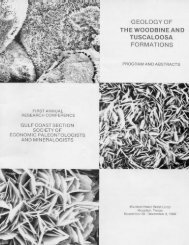Petroleum Systems of Deep-Water Basins - Gulf Coast Section SEPM
Petroleum Systems of Deep-Water Basins - Gulf Coast Section SEPM
Petroleum Systems of Deep-Water Basins - Gulf Coast Section SEPM
You also want an ePaper? Increase the reach of your titles
YUMPU automatically turns print PDFs into web optimized ePapers that Google loves.
Late Mesozoic and Cenozoic Deposystem Evolution<br />
in the Eastern <strong>Gulf</strong> <strong>of</strong> Mexico:<br />
Implications for Hydrocarbon Migration<br />
Richard H. Fillon<br />
Earth Studies Associates<br />
3730 Rue Nichole<br />
New Orleans, Louisiana 70131<br />
e-mail: fillorh@bellsouth.net<br />
Abstract<br />
A preliminary analysis <strong>of</strong> Mesozoic and Cenozoic deposystems in the eastern <strong>Gulf</strong> <strong>of</strong> Mexico, using published<br />
regional stratigraphic and depth to basement studies, reveals striking elements <strong>of</strong> deposystem history and petroleum<br />
system architecture. Integration <strong>of</strong> thirteen regional studies into a single chronostratigraphic framework provides a<br />
basis for assessing accumulation rates within eight provisional Late Mesozoic second-order depositional sequences<br />
and eight Cenozoic second-order depositional sequences spanning the interval 165 Ma to the present.<br />
Interval accumulation rate mapping reveals that major deposystems shifted in response to the changing tectonic<br />
setting <strong>of</strong> the <strong>Gulf</strong> basin. The evolving deposystems reflect changes in sequence architecture corresponding to evolution<br />
from a dynamic environment <strong>of</strong> salt tectonics and hot mobile crust in the youthful <strong>Gulf</strong> basin to cool thermally<br />
stable modern crust where gravity driven depositional patterns dominate. Shifting depocenters throughout this period<br />
differentially loaded and compacted underlying sediments, thus modifying pressure gradients that influence the lateral<br />
migration pathways <strong>of</strong> hydrocarbons. Analysis <strong>of</strong> differential deposystem loading predicts that hydrocarbon migration<br />
paths locally converge within the original Federal lease sale 181 area, principally because Late Cretaceous strata<br />
in the area are relatively thin compared to adjacent areas. While perceived hydrocarbon risk is therefore diminished,<br />
low accumulation rates for most sequences suggest that reservoir risk in a given vertical section is high. The search for<br />
productive reservoir in the area should therefore focus on specific parts <strong>of</strong> the section immediately above or below a<br />
condensed Middle Cretaceous Sequence Boundary (MCSB) interval that exhibit accumulation rates higher than the<br />
regional average. Accordingly, the late Albian-early Cenomanian (Paluxy sequence) and the middle to late Miocene<br />
(upper Miocene sequence) are preferred candidates for exploration.<br />
38

















